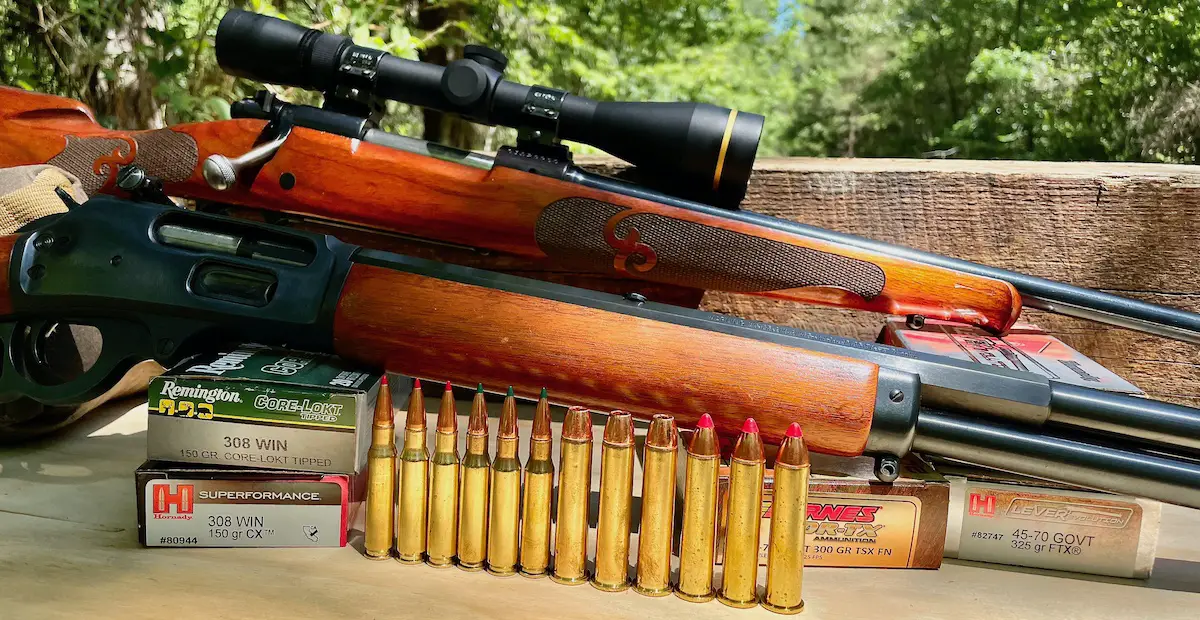Need an effective big game hunting cartridge and can’t decide between the 45-70 vs 308 Winchester?
The 45-70 vs 308 Winchester debate is a great example of how a person who doesn’t know any better can get a wildly distorted view of how two cartridges compare to each other by simply looking at their performance on paper.
While they may look very similar at first glance in certain performance categories, the 308 Winchester and the 45-70 Government are two completely different rounds ideally suited for very different hunting situations.
Want to learn more about the details of how these two cartridges stack up against each other? To include how it’s possible the little 308 Winchester can significantly outperform the much larger 45-70 Government in some circumstances?
You came to the right place and I’ll tell you everything you need to know about these two cartridges.
In this article, I investigate the 45-70 vs 308 and provide detailed information on the pros and cons of each rifle cartridge along with specific recommendations on which round one is best suited for various hunting situations so you can decide which one will work best for your individual needs.
Table of Contents
History Of The 45-70 Government & 308 Winchester
Though breech-loading rifles and cartridges saw somewhat widespread use during the American Civil War, most American Soldiers still primarily used muzzleloading rifles and paper cartridges when the war ended in 1865.
The United States Army began the search for a new breech-loading rifle that could utilize metallic cartridge cases in the years following the war and temporarily adopted the .50-70 Government cartridge and the single shot Springfield Model 1866 breech-loading rifle.
They quickly replaced the Springfield 1866 and 50-70 Government a few years later with an even newer rifle chambered in a new cartridge. Officially dubbed the Springfield Model 1873, but best known as the Trapdoor Springfield, this new rifle debuted with a new .45 caliber cartridge using a powder charge of 70 grains of black powder in a copper case.
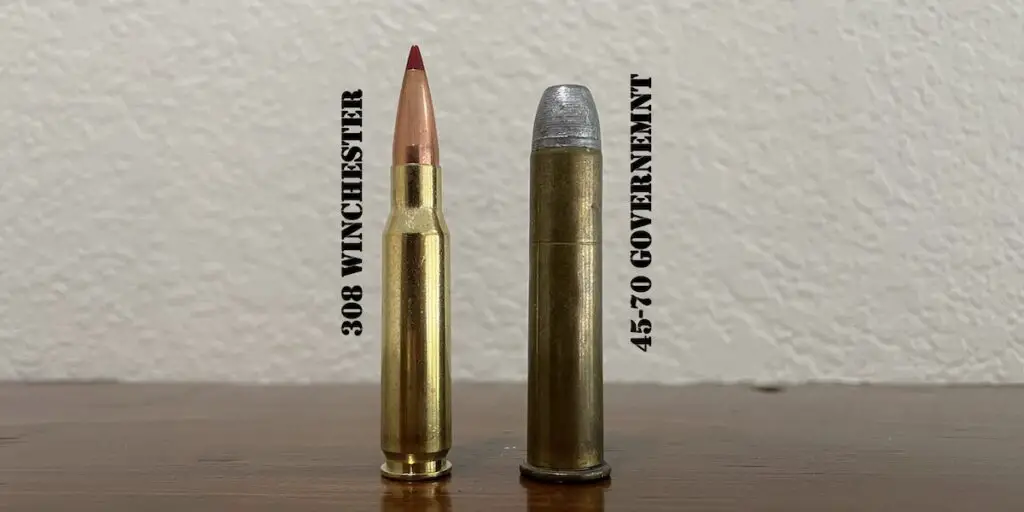
The Army used a couple of different loads firing either 405 grain or 500 grain bullets for the cartridge.
These performance specifications are where the name of the cartridge comes from.
The standard naming convention in common use at the time that consisted of the caliber of the cartridge followed by the standard load of powder in grains. Since the new cartridge was designed at the United States government operated Springfield Armory and fired either a 405 grain or a 500 grain, .45 caliber bullet propelled by 70 grains of powder, the cartridge received the designation “.45-70-405” or “.45-70-500” depending on the exact load.
Commercial publications and catalogs from that time period soon began referring to the cartridge as the “.45-70 Government” (.45-70 Govt or .45-70 Gov for short).
This original black powder 45-70 load pushed a cast lead bullet at a velocity of about 1,350 feet per second. Producing more than 1,600 foot pounds of muzzle energy, this cartridge was one of the most powerful loads available at the time and the Army used that loading through the Indian Wars in the late 1800s.
The 1873 Springfield and 45-70 Government served as the primary service rifle and cartridge used by the United States Army until the much more modern bolt-action Springfield 1892 “Krag–Jørgensen” rifle chambered in .30-40 Krag replaced it near the end of the 19th Century.
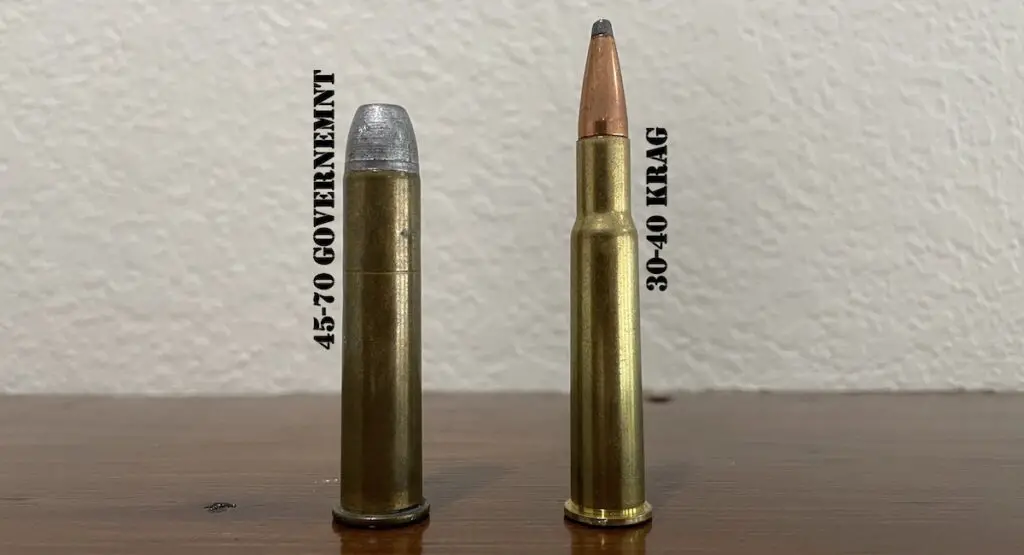
Even so, the U.S. Army continued to use various models of the Trapdoor Springfield and 45-70 cartridge in limited numbers through the Spanish-American War and Philippine Insurrection in the late 1800s and early 1900s.
Sportsmen in the United States also quickly developed an affinity for the 45-70 Govt soon after the Army adopted the round. For this reason, civilian rifle manufacturers also soon began churning out .45-70 Govt rifles for civilian hunters.
Within a few years of the government adoption of the 45-70, hunters had access to a number of high quality lever action and single shot rifles and repeaters. For instance, Winchester, Sharps, and Remington produced rifles like the Remington-Keene, the Remington Rolling Block, the Sharps 1874 “Buffalo Rifle,” the Winchester-Hotchkiss, Winchester Model 1885 “High Wall,” and the Winchester Model 1886 in 45-70.
While those original black powder 45-70 loads do not have very impressive ballistics by modern standards, the cartridge was still quite effective on the whole spectrum of North American game ranging from whitetail deer and black bear all the way up to much larger, tougher, and sometimes more dangerous species like moose, grizzly bear, and American bison.
The 45-70 dropped off in popularity and nearly disappeared completely in the early 20th Century. However, it saw a major resurgence in the second half of the 1900s.
Indeed, modern production 45-70 rifles with stronger actions can safely utilize more powerful loads utilizing smokeless powder. Those developments, combined with the high quality bullets in production today, have further improved the performance of the cartridge and breathed new life into the old 45-70.
Despite celebrating its 150th birthday in 2023, the 45-70 remains a very popular and effective hunting cartridge to this day.
Want to learn more about the .45-70 Government cartridge in detail? Read the article below.
45-70 Govt: The Ultimate Guide To What You Need To Know
Now let’s shift gears and talk about the much newer (though still pretty old) 308 Winchester.
Similar to the 45-70 Government, the .308 Winchester story begins with a search by the U.S. military for a new rifle cartridge.
In this case, the U.S. Army was looking for a new .30 caliber round that would duplicate the performance of the 30-06 Springfield, but do so out of a smaller package.
They eventually settled on the 7.62x51mm NATO round. Winchester quickly adopted that cartridge for civilian use and released to the world as the .308 Winchester in 1952.
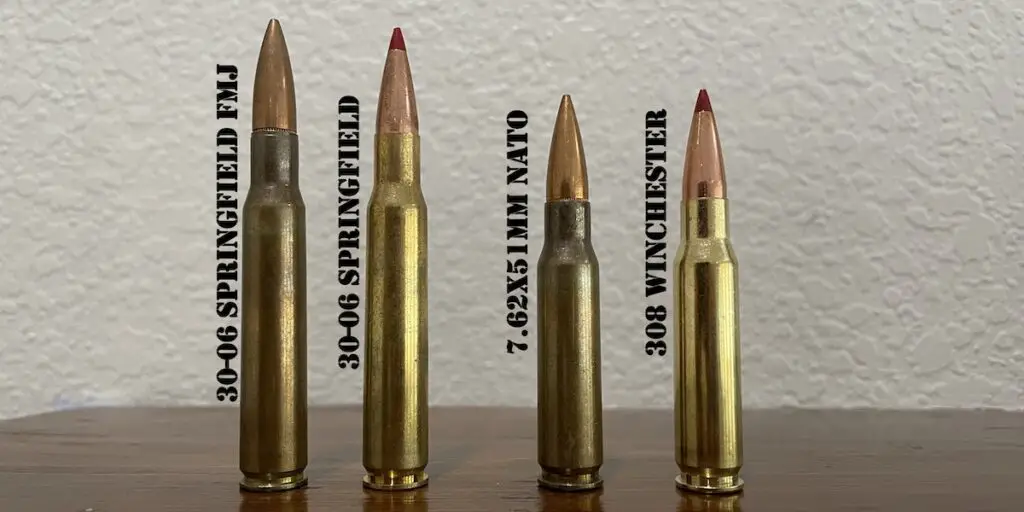
The original 7.62x51mm NATO M80 ball load fired a 146 grain full metal jacket (FMJ) bullet at 2,750 feet per second (2,469 foot pounds of muzzle energy). Designers of the cartridge accomplished their goal of essentially duplicating the 30-06 Springfield M2 Ball load of a 150 grain bullet at 2,700 feet per second.
However, the 7.62x51mm and the nearly identical .308 Winchester both delivered that performance with a much shorter case than the old 30-06 (51mm vs 63mm).
The 308 Winchester was not an instant commercial success, but hunters and shooters eventually came to appreciate the accuracy advantages the 308 offered as well as the efficient and well mannered performance of the round.
Sure, 30-06 is a more powerful cartridge, but the 308 is more efficient and can generally shoot the same weight bullet at a muzzle velocity just 100fps slower than the 30-06. And the 308 Winchester can achieve that level of performance out of a significantly smaller package that fits in a handier short action rifle, doesn’t need as long of a barrel for optimum performance, and has less recoil to boot.
Though the .30-06 remains quite popular to this day, the .308 Winchester has steadily grown in popularity over the ensuing decades and it’s now also one of the most popular and commonly used centerfire rifle cartridges in the world among both hunters and recreational shooters.
To learn more about how the 308 Winchester stacks up against the 30-06 Springfield and 300 Winchester Magnum, read this article:
308 vs 30-06 vs 300 Win Mag: Ultimate Guide
So we’ve established the 45-70 Government and 308 Winchester have very different origin stories, but how do they compare to each other in more practical terms?
To start off with, they have almost completely different external dimensions.
308 vs 45-70 Cartridge Sizes
The photos below illustrate the massive differences between the 45-70 vs 308 Winchester.
First, the 45-70 Government uses a very large diameter, straight wall case with a rim.
On the other hand, the 308 Winchester is physically a little longer overall and uses a rimless, bottle-necked case design that’s smaller in diameter than the 45-70 case.
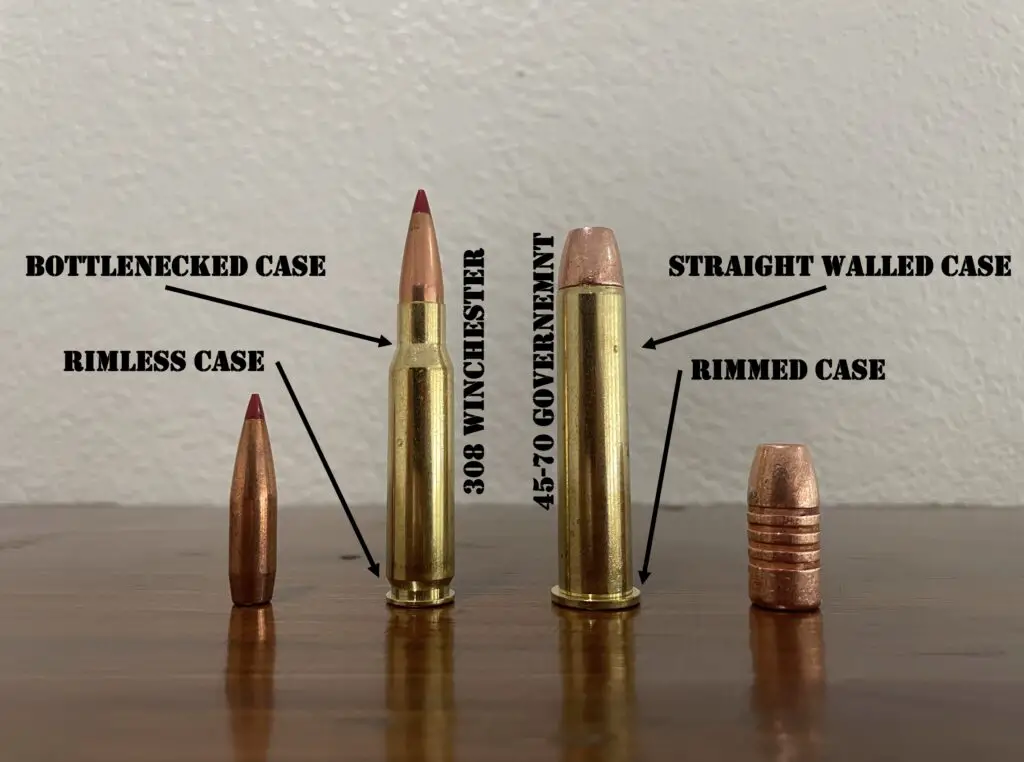
We’ll discuss this in more detail later, but realize those differences in case design heavily influence the rifles each cartridge is available in.
All told, the 308 Winchester has an overall length of 2.81″ and a case length of 2.015″ vs a 2.55″ overall length and a 2.105″ case length and for the 45-70 Government.
Heck, the .308 Winchester case is nearly as long as the entire .45-70 Government cartridge!
However, the .45-70 Govt utilizes a much larger diameter case that has a .608″ rim diameter and a .504″ body diameter at the base. As I mentioned earlier, the .45-70 utilizes a “straight walled” design with no shoulder and no body taper.
This is in stark contrast to the 308 Winchester which is not nearly as large in those respects: it has a .473″ rim diameter, a .470″ body diameter at the base and then tapers down to .454″ in diameter at the 20 degree shoulder on the case.

All told, the 45-70 Govt can hold an astounding 55% more powder than the 308 Winchester as a result of its larger diameter case!
As we’ll discuss shortly, the details vary a lot here depending on the specific rifle 45-70 ammo is intended for use with (a Trapdoor Springfield vs Marlin 1895 vs Ruger No. 1).
For reference, modern 45-70 Government hand loads and factory ammo typically use 25-60 grains of smokeless powder (depending on the rifle it’s designed for use with) while 308 Winchester factory ammo often uses 35-50 grains of smokeless powder.
Bullet weight and bullet diameter are two other important differences between the 45-70 vs 308 Win.
The .308 Winchester uses .308″ diameter bullets while the 45-70 uses much larger .458″ bullets.
Most .308 Winchester ammo typically has bullet weights in the 110gr to 180gr range, with 150gr, 165gr, 168gr, and 180 gr bullets being the most popular.
On the other hand, while it’s certainly possible to find .45-70 ammo utilizing bullets weighing as little as 250 grains and as heavy as 540 grains (possibly even more in some cases), most .45-70 factory loads use 300 grain, 325 grain, 350 grain, or 405 grain bullets.
Finally, the 308 Winchester is also loaded to a much higher SAAMI maximum average pressure of 62,000psi vs just 28,000psi for the 45-70 Government.
These pressure figures can be somewhat misleading though.
This is because the 308 Winchester was designed from the start to use smokeless powder, while the .45-70 Govt was originally designed for black powder before being adopted to use smokeless powder many years later.
The 45-70 is an older cartridge and there’s a wide range of rifles manufactured in that chambering. For this reason, ammunition manufacturers will often manufacture ammunition in different power levels for use in different rifles.
For instance, my Lyman 50th Edition reloading manual specifies 3 different categories of 45-70 handloads: lower pressure loads safe for use in a Trapdoor Springfield (maximum pressures up to 18,000 CUP), those safe to use in stronger Marlin 1895 and Winchester 1886 rifles (maximum pressures up to 28,000 CUP), and those safe to use in the single shot Ruger No. 1 (maximum pressures in up to 40,000 CUP).
We’ll cover this in more detail later, but realize the SAAMI standards for the .45-70 can be artificially low because of all those older rifles.
Even so, the 308 Winchester is still designed to operate at significantly higher pressures than the 45-70 Government in general.
Note: while the powder capacity figures listed below do give a good indication of the differences between the two cartridges, exact case capacities vary slightly according to the brand of brass used.
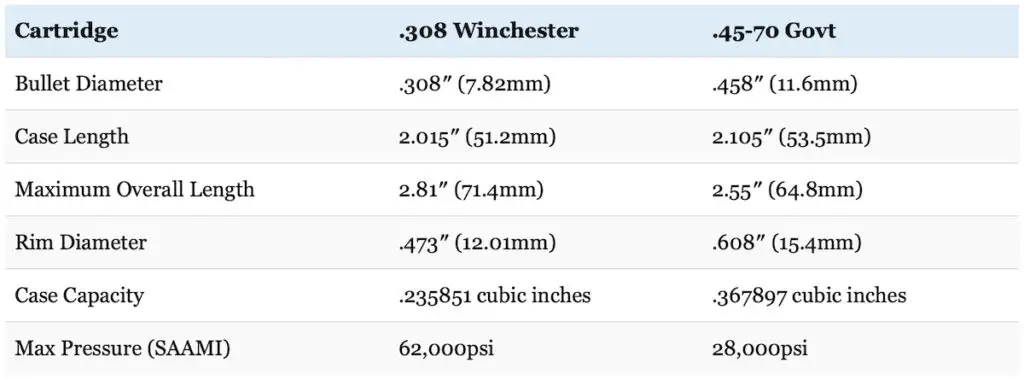
45-70 vs 308 Ballistics
As you might guess based on their external dimensions, there is a massive difference in 45-70 vs 308 ballistics. This is illustrated in the table below comparing Hornady LEVERevolution and Precision Hunter, Barnes VOR-TX, and Remington Core Lokt factory ammunition.
The 308 Winchester loads use 150gr TTSX (.440 BC), 180gr Core Lokt (.383 BC), and 178gr ELD-X (.552 BC) bullets.
These 45-70 Government loads use 300gr TSX (.163 BC), 405gr Core Lokt (.281 BC), and 325gr FTX (.230 BC), bullets.
Notice that the various bullets used in all those .308 Winchester loads all have a much higher BC than those used in all of the various 45-70 loads.
The Barnes loads use lighter for caliber bullets, the Hornady ammunition options use heavier and higher BC bullets available for each cartridge, and the Core Lokt loads use the heaviest bullets for each cartridge that are commonly available in factory loads.
Additionally, the Remington Core Lokt loading for the 45-70 is a very low powered loading that mimics the original ballistics of the cartridge and is safe to use in a Trap Door Springfield.
All six loads used a 100 yard zero.
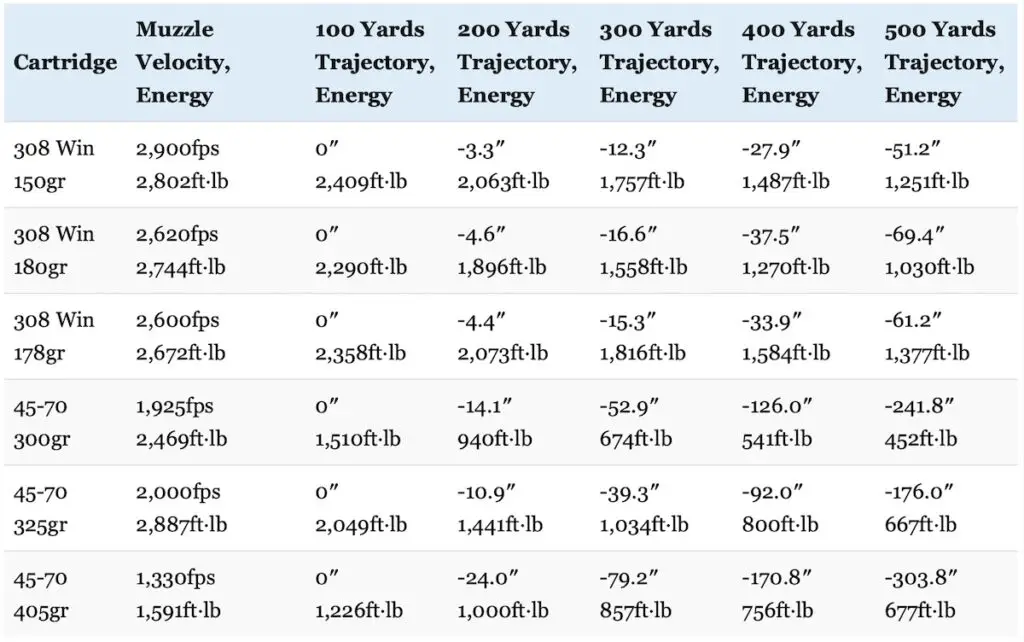
As you can see, the two cartridges actually start out fairly evenly matched in the energy department (with the low velocity 405gr 45-70 load being a notable exception). The 325gr 45-70 load has the most muzzle energy, followed closely by the 150gr, 180gr, and 178gr 308 loads, then the 300gr 45-70 load, and then finally we have the 405gr 45-70 load bringing up the year.
While all of the 308 loads start out going considerably faster than the 45-70 loads, the 45-70 utilizes much heavier bullets. This works to even things out in the energy department at first.
Things rapidly change as we go downrange though.
Indeed, the 308 Winchester quickly leaves the 45-70 in the dust in both the trajectory and retained energy departments.
This is because the 308 utilizes much more aerodynamic bullets pushed at a significantly faster velocity.
The 308 Winchester doesn’t have a reputation for being an extremely flat shooting round, especially when compared to cartridges like the 270, 30-06, or 300 Win Mag, but it’s still a modern, high velocity cartridge.
Even the fastest 45-70 loads can’t hold a candle to the 308 Winchester in this area and, depending on the specific loads compared, the 308 has a velocity advantage in the 600-1,490fps range!
Not only does the 308 Winchester start out going quite a bit faster, but the higher BC bullets the 308 utilizes hang onto velocity and kinetic energy much better than those used by the 45-70.
Every 308 Winchester load has more (and sometimes significantly more) kinetic energy than every 45-70 load in this comparison by the time they reach the 100 yard mark.
That advantage continues to grow as the range increases as well.
Heck, every single 308 load carries more than 1,500ft-lbs of energy out past 300 yards and over 1,000ft-lbs of energy past 500 yards.
Even that high performance 325gr LEVERevolution load for the 45-70 dips below 1,500ft-lbs of kinetic energy short of 200 yards and below 1,000ft-lbs of energy just past 300 yards!
The differences are even more stark in terms of trajectory. The 45-70 Government is the definition of a lower velocity cartridge with a very rainbow like trajectory.
Here’s an example to make this point even more clear.
The bullet drop figures in this chart are based on a 100 yard zero. Well, the 308 will still have significantly less drop than the 45-70 at 300 yards with a 100 yard zero even if you give the 45-70 a 200 yard zero.
Doing so will reduce the 325gr 45-70 load’s bullet drop from 39″ to 23″, but that’s still about 7″ more bullet drop than the most arching 308 load at that same range zeroed at 100 yards!
Here’s how each 308 Winchester load compares individually to the comparable 45-70 Government load in terms of muzzle energy, retained energy at 300 yards, bullet drop at 300 yards, retained energy at 500 yards, and bullet drop at 500 yards:
Barnes: the 308 Winchester has 13.5% more muzzle energy, 160% more kinetic energy at 300 yards, 40.6″ less bullet drop at 300 yards, 177% more retained energy at 500 yards, and 190″ less bullet drop at 500 yards.
Hornady: the 45-70 Government has 8% more muzzle energy, 43% less kinetic energy at 300 yards, 24″ more bullet drop at 300 yards, 51% less retained energy at 500 yards, and 114″ more bullet drop at 500 yards.
Remington: the 308 Winchester has 72.4% more muzzle energy, 82% more kinetic energy at 300 yards, 62.6″ less bullet drop at 300 yards, 52% more retained energy at 500 yards, and 234″ less bullet drop at 500 yards.
So, the big takeaways so far are the two cartridges start out with generally very similar muzzle energy levels (aside from the 405gr 45-70 load), but the 308 Winchester is flatter shooting and retains much more energy as ranges increase.
Now let’s talk about another important factor: wind.
The chart below compares how much a 10 mile per hour crosswind impacts those same 308 Winchester and 45-70 Government loads out to 500 yards.
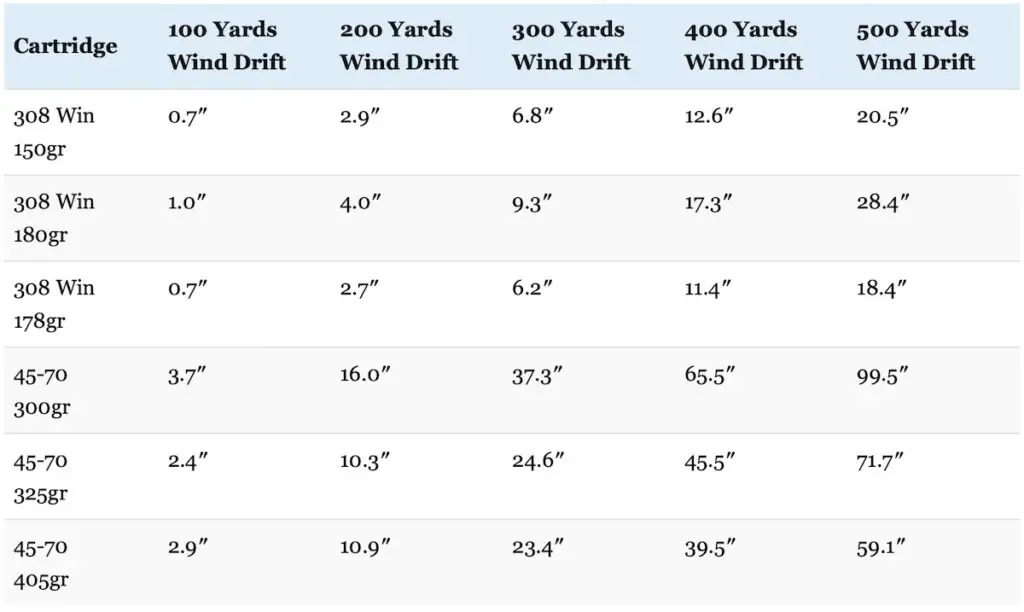
Once again, the 308 Winchester blows the 45-70 out of the water here too.
This is due to the fact that the 308 Winchester fires higher BC bullets at a much faster velocity.
Why is this the case?
Assuming the same wind conditions, wind deflection is dependent on bullet velocity and BC. However, small changes in ballistic coefficient result in bigger changes in wind deflection than is the case with velocity.
This is why the high BC 178gr ELD-X load for the 308 Winchester performs better than everything else on this list. This is also why the 405gr 45-70 load actually has less wind deflection than the faster 325gr 45-70 load.
Now let’s talk about recoil.
The table below compares the recoil produced by handloads that are very similar to the 178gr and 325gr loads for the 308 Winchester and 45-70 Government respectively when fired from 8 pound rifles.
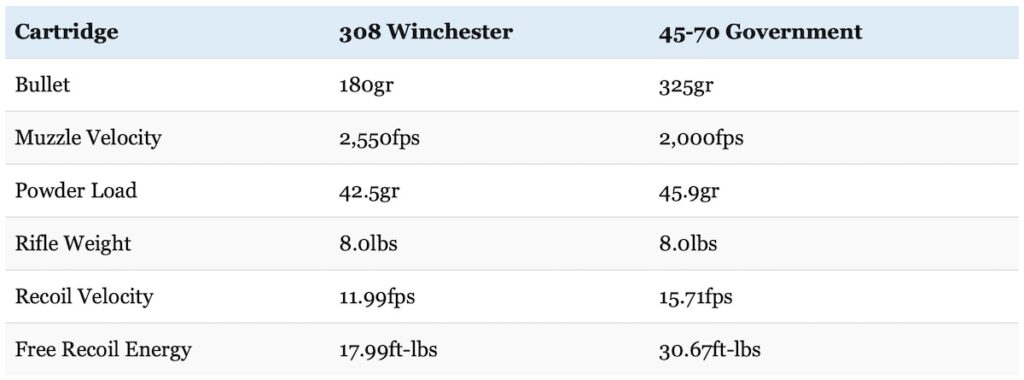
As you can see, the 45-70 Government has a lot more recoil than the 308 Winchester.
This is because the 45-70 Govt fires a much heavier bullet and uses more powder to achieve that performance. For this reason, the 45-70 has about 70% more free recoil energy than the 308 Win!
While a heavy load for the 45-70 is probably towards the upper end of what a typical hunter or shooter can handle, it’s still not on the level of something like a 338 Lapua or 458 Win Mag either.
Using a rifle with a good recoil pad will dampen that recoil to a certain extent. The same is also true if you use a suppressor like a Banish 46 on your rifle (which is a possibility with certain new production Marlin 1895s that have a threaded barrel).
Even so, the 45-70 will still probably recoil quite a bit more than a 308.
Additionally, there are a couple of other factors that are also worth discussing.

First, the 45-70 Government uses larger diameter bullets than the 308 Winchester.
Specifically, the larger diameter .458″ bullets it uses have about 121% more frontal surface area (also known as cross sectional area) than the .308″ bullets used by the 308 Winchester (.1647 vs .0745 square inches). All other things being equal, a bigger bullet will make a bigger hole, cause more tissue damage, and result in more blood loss.
This is a gigantic advantage in favor of the 45-70 and, especially when combined with the cartridge’s good muzzle energy, those larger diameter bullets can certainly also be helpful on bigger and/or tougher game at close range.
On the other hand, the 308 Winchester has an edge over the 45-70 Government in terms of bullet sectional density (SD) in most cases.
Sectional density (SD) is a measure of the ratio of the diameter of a projectile to its mass. All other things equal, a heavier projectile of a given caliber will be longer and therefore have a higher sectional density and consequently penetrate deeper than projectiles with a lower mass and sectional density.
150 grain, 165 grain, and 180 grain .308″ bullets have sectional densities of .226, .248, and .271 respectively.
250 grain, 300 grain, 325 grain, and 405 grain .458″ bullets have sectional densities of .170, .204, .221, and .276.
As you can see, even the lighter 150gr .308″ bullets have a higher sectional density than .458″ bullets 325 grains and lighter.
You need to be careful when drawing conclusions based solely on sectional density because other characteristics like bullet construction and momentum are important factors affecting bullet penetration as well.
All things considered, I think it would be fair to say that overall the 45-70 Government is still a heavier hitter at very close range, but the 308 Winchester punches above its weight in terms of terminal performance.
This is because the 308 Winchester is a more efficient cartridge that can fling a higher BC bullet at faster velocity without requiring generating as much recoil as the 45-70. The end result is a cartridge that offers advantages in trajectory and wind deflection with a light to moderate level of recoil that can assist the shooter in shot placement.
Speaking of shot placement, that brings me to my next point.
45-70 vs 308 Accuracy
What about 45-70 vs 308 Winchester accuracy?
External ballistics are certainly important, but great performance on paper doesn’t mean a darn thing if you can’t hit your target.
Which one is in terms of accuracy?
I have to give the edge to the 308 Winchester in this area.
I’m not saying the 45-70 isn’t capable of great accuracy.
Details will vary on the exact rifle, ammunition, and shooter in question. And yes, there will be instances of 45-70 rifles shooting better than 308 rifles.
On average, the 308 has better accuracy potential with factory rifles and ammunition. That cartridge just has a reputation for inherent accuracy. This is a big part of the reason why it has seen so much use in the hands of military and police snipers as well as competition shooters over the years.
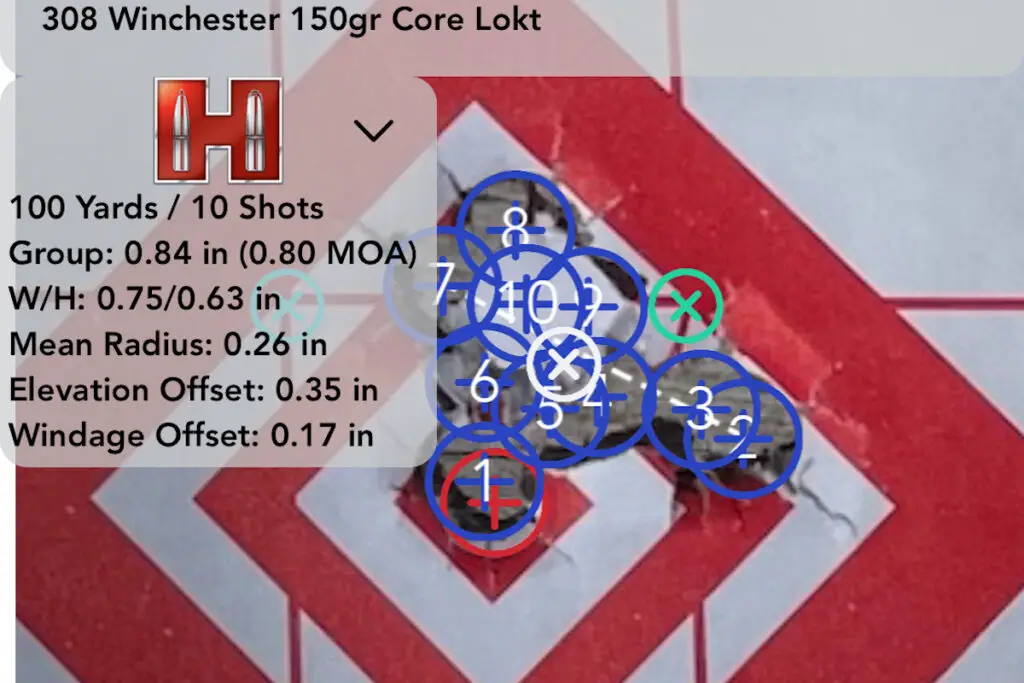
Plus, the .308 Winchester is also much more commonly available in bolt-action rifles which are generally more accurate than lever-action rifles (where the 45-70 is most common).
So where do we stand overall?
45-7o vs 308 Winchester
The .308 Winchester fires smaller diameter, lighter, and higher BC bullets at a much faster velocity than the .45-70 Government. The 45-70 generally has more kinetic energy at close range along with significantly more recoil, but the 308 has a much flatter trajectory, better resistance to wind deflection, and much better energy retention at longer range.
308 vs 45-70 Government Ammo
Both the 308 Winchester and 45-70 cartridges are fairly popular among hunters and shooters in the United States. However, the 45-70 cannot hold a candle to the .308 Winchester in terms of raw ammo sales though.
For example, MidwayUSA currently lists a 164 308 Winchester ammo offerings compared to just 47 45-70 ammo loads on their web site as I write this.
So, I wouldn’t say 45-70 ammo is especially rare or hard to find, but there are simply just a lot more 308 ammo options.
In general, 308 Winchester ammo is often cheaper than .45-70 ammo too. This is especially true with FMJ ammo intended for use at the range (which is available in 308, but not 45-70).
There are some other important differences in the types of ammo available for each cartridge though.
First, the 45-70 tends to use heavier and more solidly constructed rifle bullets while the 308 Winchester uses bullets that span the whole spectrum of use cases from lightly constructed varmint bullets to medium weight and toughness bullets intended for use on deer, to heavier, premium bullets designed for use on bigger game.
There’s some overlap there though.
For instance, many ammo choices for both cartridges work great on deer sized game (both are available in the Remington Core-Lokt and Winchester Power Point lines). Additionally, the Barnes VOR-TX line is an example of an ammo option loaded with tougher bullets that’s available as a factory load for both the 308 and 45-70.
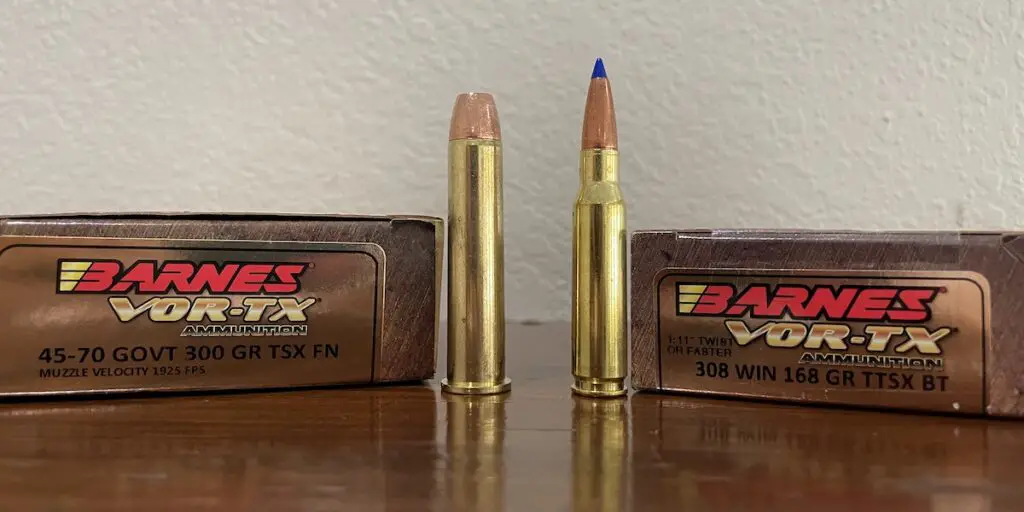
The big ammunition manufacturers like Barnes, Federal Premium, Hornady, Remington, and Winchester all produce a decent selection of .308 Winchester and .45-70 Govt ammunition.
Both cartridges are offered in most of the really popular hunting ammo lines: Barnes VOR-TX, Federal Power Shok, Federal Fusion, Hornady Subsonic, Remington Core Lokt, and Winchester Super X (just to name a few).
Additionally, there are cases where one cartridge is available in a certain ammo line, but the other isn’t. This reflects both the performance characteristics and the common uses of each cartridge.
For instance, since the .45-70 Govt is most common in lever-action rifles with tubular magazines, most loads feature a round nosed or flat-tipped bullet. This is because bullets are stacked one in front of the other and recoil could potentially cause a bullet with a pointed tip to detonate the primer of the cartridge in front of it.
Unfortunately, those round or flat nose bullets have a low ballistic coefficient and poor downrange performance. The upside is flat nosed bullets tend to perform well on game and deliver excellent terminal performance.
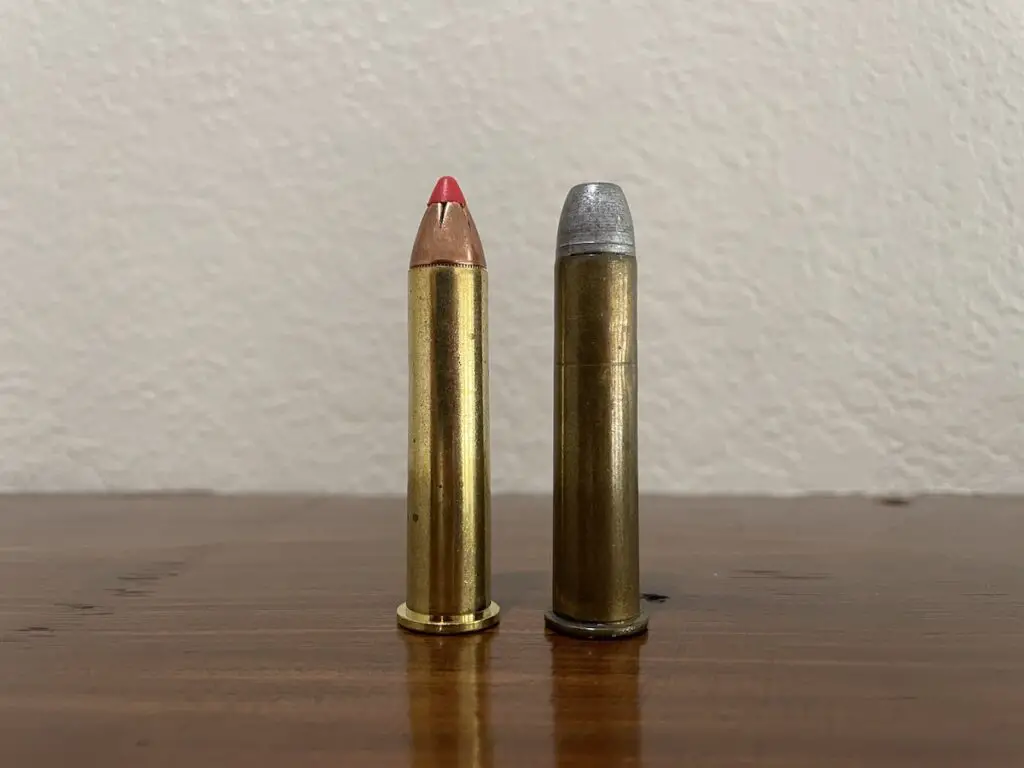
Designers at Hornady attempted to remedy the problem with those low BC bullets with their “LEVERevolution”, line of ammunition for cartridges like the .30-30 Winchester, .35 Remington, and .45-70 Govt that are most popular in lever guns. This ammo is loaded with bullets that have a pointed, flexible, polymer tip.
This ammunition doesn’t bring those cartridges up anywhere close to the level of stuff like the 7mm Rem Mag or 300 Win Mag (or even the 308 as I demonstrated earlier), but LEVERevolution ammunition still uses more aerodynamic bullets and generally has a higher velocity than typical ammunition for those cartridges. As a result, this ammunition does have a slightly flatter trajectory, a slightly increased effective range, and retains more energy at typical hunting ranges.
Those polymer tips also help initiate expansion upon impact and they also tend to deliver devastating terminal performance on all manner of game.
The situation is quite a bit different with the 308 Winchester though. Since it’s more common in bolt-action rifles and the AR-15 platform and is much better suited for use on game at longer range, most 308 Winchester loads use pointed bullets.
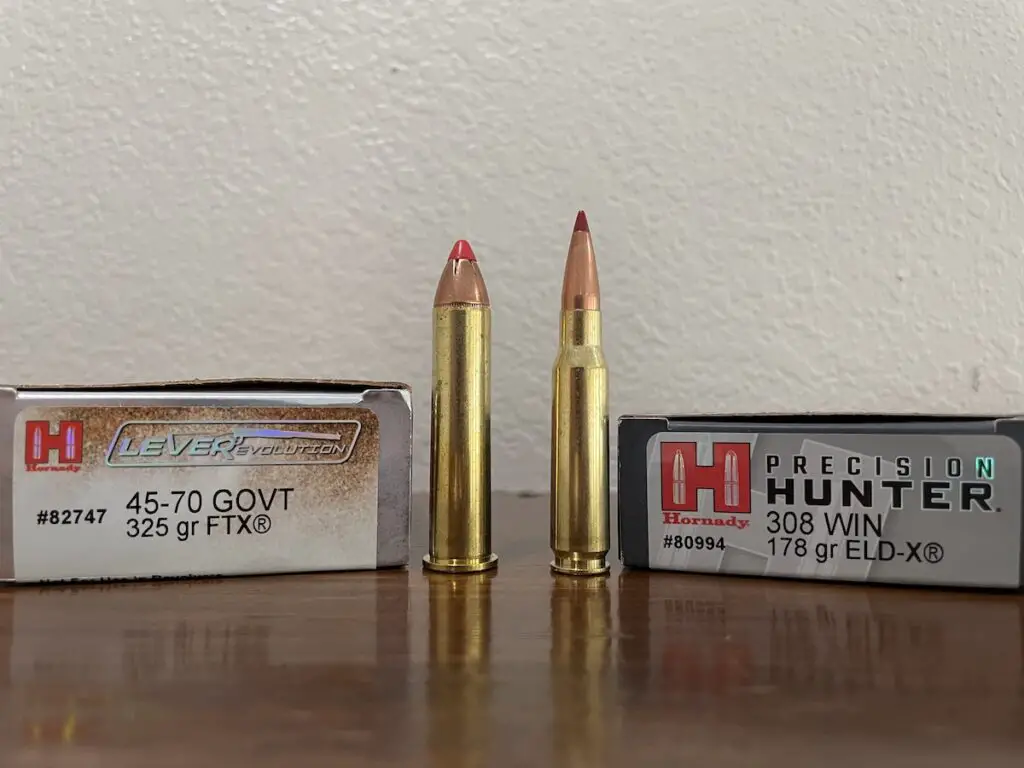
Additionally, Hornady offers the cartridge in their Precision Hunter line of ammunition, which is designed for use at extended range. This ammo is intended to deliver fantastic accuracy, excellent energy retention at long range, and devastating terminal performance at lower impact velocities.
As you can imagine, Hornady only included cartridges in their Precision Hunter lineup that were suitable choices for use on game out past 200 yards in the first place. This is why Hornady Precision Hunter ammo is available in cartridges like 6.5 Creedmoor, 270 Winchester, 30-06 Springfield, and 300 Win Mag, but not 45-70.
In terms of availability, the difference between the 308 and 45-70 became even more apparent.
45-70 ammo disappeared off shelves completely for months at a time, but the 308 was the only centerfire rifle cartridge I never had trouble finding ammo for.
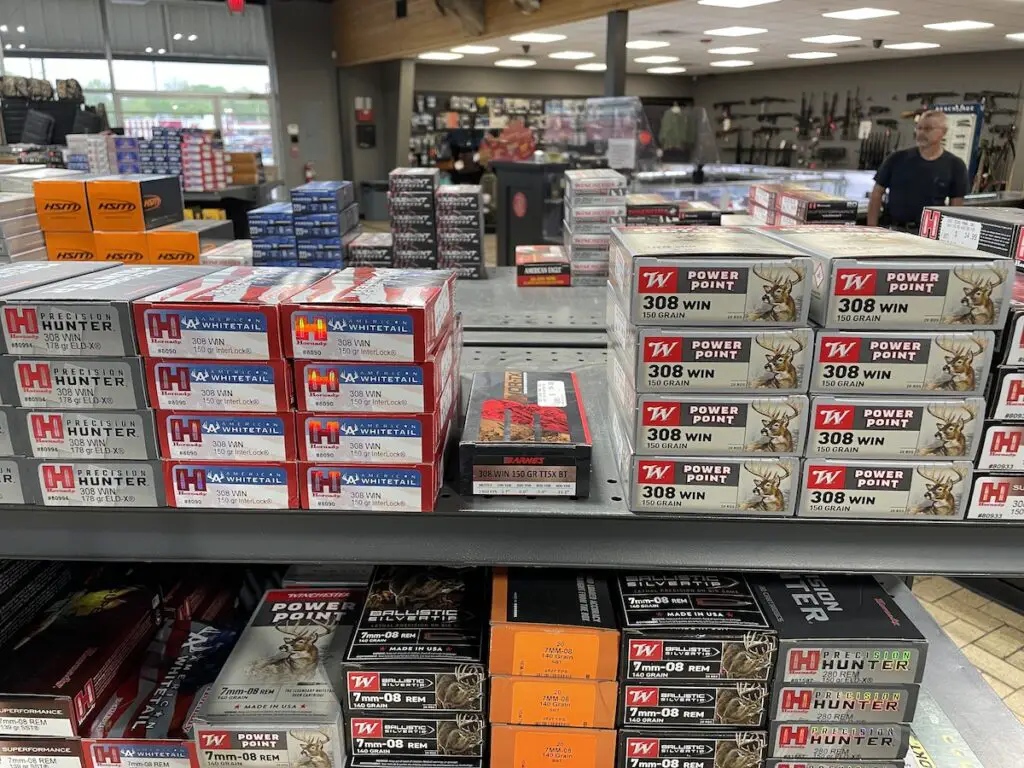
So take all that for what you will.
During the 2020-2023 ammo shortage, the difference between the two cartridges has become pretty scrambled and (at least where I live and shop) 308 Winchester ammo is usually easier to find than ammo for the 45-70.
If you’d like to learn more about some of the various hunting ammunition choices for the 308 Winchester and 45-70 Government, read these articles:
Best 308 Winchester Hunting Ammo
Best 45-70 Government Ammo For Hunting
45-70 vs 308 Winchester Rifles
There is also an excellent selection of good hunting rifles chambered in both 308 Winchester and .45-70 Government. Similar to the ammunition selection though, there’s a much larger selection of 308 Winchester rifles.
For example, Sportsman’s Warehouse currently lists a staggering 493 308 Winchester rifles, but just 36 45-70 rifles on their web site as I write this article.
Going beyond the sheer number of rifles available for each round, there’s also a big split in the types of rifles available for the two cartridges.
Indeed, this is another significant difference between the 45-70 vs 308.
Let’s drill down into things in a little more detail.
Since it’s a rimmed cartridge, .45-70 Government is most commonly (though not exclusively), chambered in single shot and lever action firearms.
On the other hand, the rimless 308 Winchester is widely available in bolt-action and semi-automatic rifles. The 308 is also available in a few lever action rifles like the Browning BLR, Winchester Model 88, and the Savage Model 99 (all of which use a box magazine and present no safety hazard with pointed bullets).
None of those specific lever-action rifles were produced in 45-70 though.
I mentioned earlier that the Springfield 1873, Remington-Keene, the Remington Rolling Block, the Sharps 1874 “Buffalo Rifle,” the Winchester-Hotchkiss, Winchester Model 1885 “High Wall,” and the Winchester Model 1886 were examples of 45-70 rifles produced in the late 1800s.
In addition to rifles like those that are still floating around out there, there are several different firearms in current production chambered in that cartridge.
First, the Marlin 1895 lever action (which is the bigger brother to the Marlin 336) is likely the single most popular rifle currently manufactured in .45-70. Ruger took over production of Marlin rifles a couple years ago and those great Marlin lever guns are once again available in several configurations with different barrel lengths, different magazine lengths, and a wide range of finishes and styles.
For instance, Marlin offers a couple versions of the 1895 with a more “classic” feel as well as a Dark Series Model 1895 with a bunch of modern features like a Picatinny Rail, M-LOK® attachment slots, and a threaded barrel for use with a suppressor or muzzle brake.
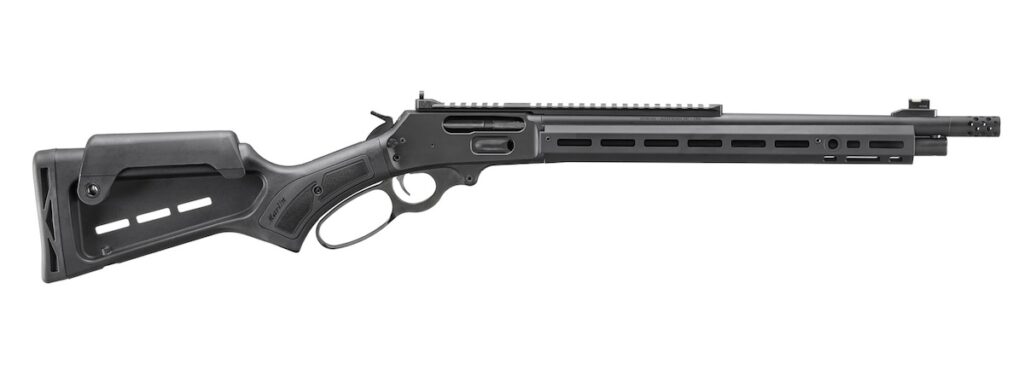
On the other hand, the Marlin Model 1895G Guide Gun should appeal to those who want a more traditional look. This particular model is one of the most iconic .45-70 rifles in current production and is ideally suited for hunting guides in places like Alaska who need a fast pointing and hard hitting rifle in case they must deal with an angry moose or brown/grizzly bear at close range.
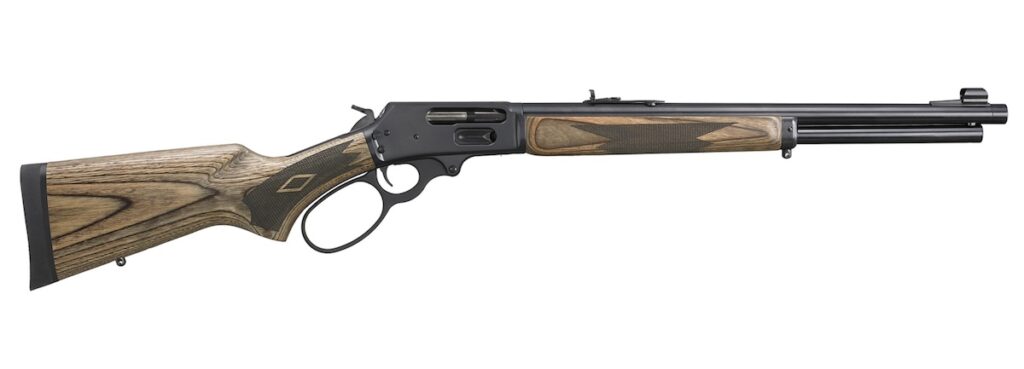
In addition to those Marlin lever action rifles, the various Henry .45-70 rifles are also very nice. Winchester also continues to manufacture a modern version the legendary lever action Model 1886 in .45-70 as well. CVA also produces their single shot Scout rifle in 45-70 Government too.
Additionally, though it’s no longer in current production, the Sturm, Ruger and Co. produced the Ruger No. 1 single shot rifle in .45-70 for a time and those rifles can be found occasionally on the secondary market.
Finally, gunsmiths converted a number of Siamese Mauser bolt action rifles to .45-70 over the years, so they’re an option (and really the only option I know of) for someone who wants a bolt action .45-70.
The situation is much different for the much newer 308 Winchester.
Winchester originally offered the 308 in the Model 70 along with their Lever Action Model 88 and semi-automatic Model 100.
Winchester still offers the 308 in the Model 70 (and their newer bolt action XPR rifle) to this day.
The same is true of basically any hunting rifle you can think of from darn near any manufacturer.
For instance, Remington produces Model 700 rifles in .308 Winchester. The same is true for the Bergara B-14, Browning AB3 and Browning X-Bolt, Christensen Arms Ridgeline, Mossberg Patriot, Ruger American, Ruger Hawkeye, Savage Axis, Tikka T3, and Weatherby Vanguard.
Additionally, the .308 Winchester is relatively common in semi-automatic sporting rifles like the Browning Automatic Rifle (BAR), AR-10, and M1A.
What about barrel lengths?
Models for both cartridges have 22″ long barrels (and sometimes even longer barrels), but those longer 22″ and 24″ barrels tend to be more common on rifles chambered in .308 Winchester.
That’s not a hard and fast rule though and there’s actually quite a bit of overlap in barrel lengths with 45-70 vs 308 rifles. Indeed, barrels in the 16″ to 18″ range are pretty common for both cartridges.
Here are a couple of examples.

Marlin produces their 1895 Trapper in 45-70 with a very short, 16.17″ barrel, an overall length of 34.25″, and a weight of 7.1 pounds.
This ultra-compact rifle is great for maneuvering through thick brush without too much difficulty while still giving the user a fast handling and hard hitting tool to use at close quarters if necessary.
While they market the rifle for trappers (and it’s great for them), this rifle is not limited to just that crowd either. The same virtues that make the 1895 Trapper wonderful for the trapping community also make this a nice rifle for still hunters in thick timber as well as deer hunters in tree stands or ground blinds who need an easy to maneuver rifle.
And like I said, 308 rifles are available in compact models as well.
For instance, Ruger offers their Hawkeye Compact rifle in .308 Winchester.

The rifle has a 16.5″ barrel and an overall length of 35.5″. It’s not quite as small as the 1895 Trapper, but it comes close.
On the other hand, the 308 Winchester is available in numerous rifles that are much better suited for open country hunts.
Winchester’s Model 70 Long Range MB falls at the complete opposite end of the spectrum from the 1895 Trapper and Hawkeye Compact.
With a 24″ long barrel and an overall length of 44″, this rifle is much better suited to taking a long poke across the prairie at an antelope or mule deer than for quietly maneuvering inside a box blind.

In addition to all that, there are also more budget friendly options for the 308 Winchester than is the case for the 45-70. Aside from the single shot CVA Cascade, there just aren’t many 45-70 rifle options available for less than $600.
308 vs 45-70 Government: Which Is Right For You?
With good shot placement and when using appropriate bullets, the .45-70 Government and .308 Winchester are both deadly on medium to large sized game and can cleanly take every species of big game in North America.
Each cartridge has very different strengths and weaknesses though.
You’ll see what I mean when I dig into the details.
Do you primarily hunt medium sized game like whitetail deer, feral hogs, or black bear at ranges within 200 yards? The 308 Winchester and 45-70 Government are both incredibly effective in that role. Both are great deer hunting cartridges and will certainly get the job done on similar sized game like hogs and black bear too.
Joseph von Benedikt used a new production Marlin 1895 in .45-70 (with an assist from a Banish 46) to take a black bear on a hunt over hounds in Idaho during 2023 with fantastic results.
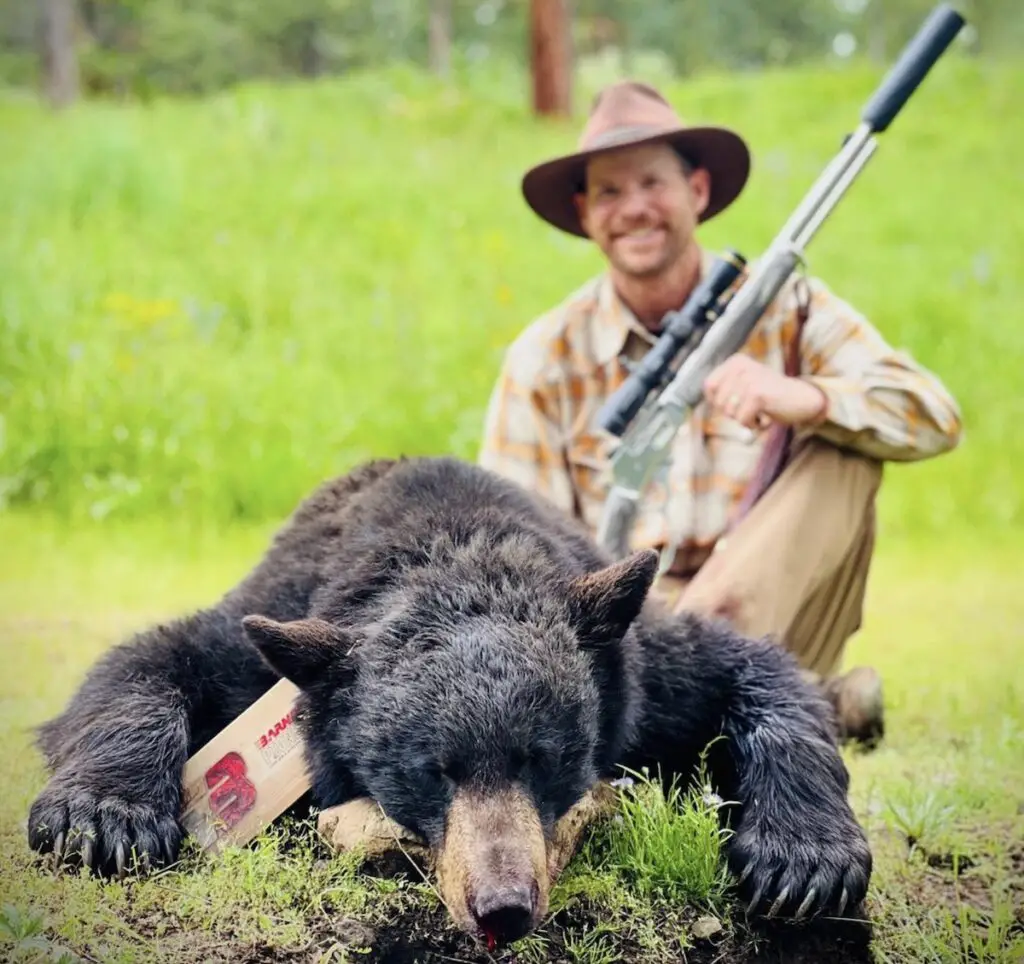
A rifle chambered in 308 Winchester would have worked fine on his hunt too. However, conditions like that where the hunter must potentially trail those hounds for several miles over rough terrain and though thick brush before taking a shot at close range just scream for a handy, yet hard hitting lever gun in something like 45-70.
What about deer hunting?
Funny enough, the 308 and 45-70 were the first two cartridges I killed deer with as a young man (and accounted for 4 of my first 5 deer).
I killed my first two deer (both small bucks) with a Winchester Model 70 Featherweight in 308. I killed my first doe with my Marlin Model 1895 in 45-70 a couple years later. I took a bigger buck using a Remington Model 8 in 32 Remington the following year, but killed another doe later that same year with my 45-70.
I was hunting out of deer stands in areas where shots were typically in the 50-150 yard range (in other words, ideal conditions for the 45-70) and both cartridges performed great.
None of those animals went more than 50 yards afterwards either.
It’s also worth mentioning that Milo Hanson used a Winchester Model 88 lever action rifle chambered in 308 Winchester to take the current Boone & Crockett whitetail back in 1993.
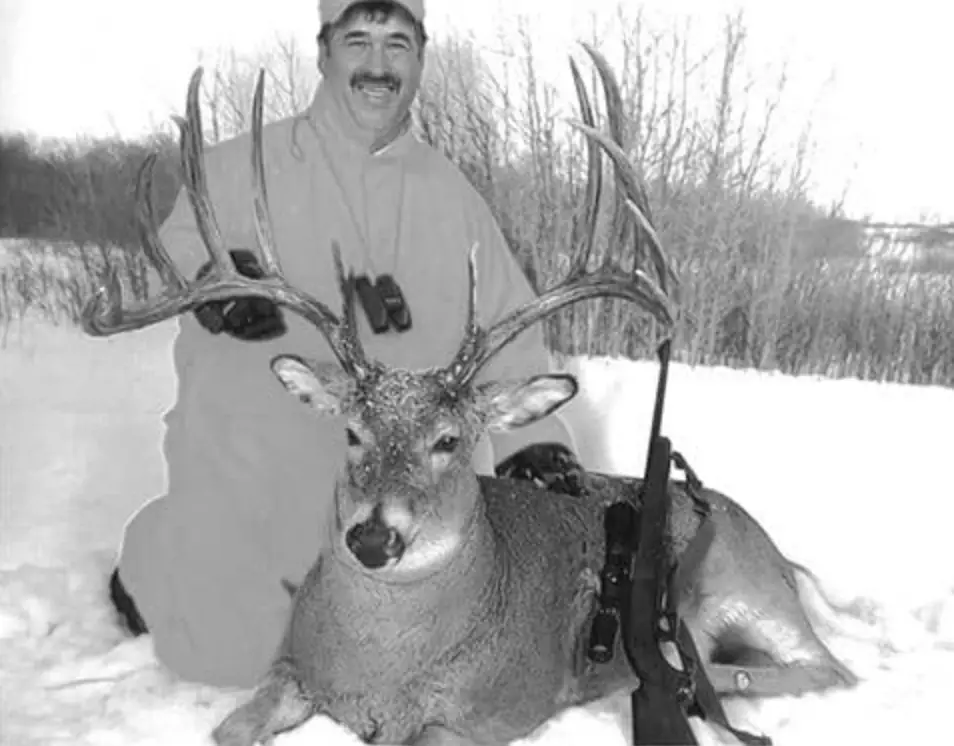
What about if you’re deer hunting in a state like Iowa or Ohio that requires hunters to use a straight walled cartridge? Well, it’s illegal to hunt deer with bottlenecked rounds like the .308 Winchester in those states, so the 45-70 is definitely the better choice in this situation.
Beware that the 45-70 is a legal cartridge in some, but not all of the so called “straight wall states” though. For instance, it’s definitely not legal to use in southern Michigan as I write this. Look into the details and make 100% sure you’re not violating hunting regulations before going afield.
If you can’t use the 45-70 where you’re deer hunting, then I’d recommend the 350 Legend or 450 Bushmaster instead.
Are you looking for a more compact rifle that’s better suited for a younger and/or smaller framed hunter?
Or maybe you want something better suited for a more recoil shy hunter?
In each case, the 308 Winchester is absolutely the better option.
While the 308 Winchester does have a little more recoil than other cartridges like the 243 Winchester and 6.5 Creedmoor, it’s still an excellent cartridge for new, small framed, and or recoil shy hunters. This is especially true when using light recoiling handloads or certain factory loads (like the Hornady Custom Lite line).
Like I mentioned earlier, I killed my first two deer with a 308 Winchester using special handloads my dad made for me and they performed flawlessly.
Which cartridge is ideal for a hunter going afield in very thick conditions or who will be hunting from a smaller box blind?
Like I mentioned earlier, the overlap in 45-70 vs 308 rifles with shorter barrels means there are a surprisingly large number of compact rifles in both cartridges.
It might be a wash in this area and the better choice for you is probably a matter of personal preference and availability. Either will certainly work.
Are you looking for the cartridge better suited for long range hunting for game like mule deer or pronghorn in open country where you might need to take a shot at several hundred yards? The 308 Winchester is definitely the better choice here. With a significantly flatter trajectory and more resistance to wind, the 308 Winchester performs much better than the 45-70 at longer ranges, particularly on thin skinned game like mule deer, pronghorn, and sheep.
I don’t necessarily recommend using the 308 Winchester for extremely long hunting situations, but the video below is a good demonstration of what the cartridge is capable of in the right hands and with the right bullet.
Speaking of elk, do you want to hunt larger game animals like kudu, eland, red stag, elk, or moose? Both the 308 and 45-70 cartridges will certainly work and lots of people have used them with success on bigger game.
The larger frontal diameter of the 45-70 Government combined with it’s similar retained energy to the 308 (at very close range) are definitely helpful when trying to cleanly take a big animal like that. After all, there’s something to be said about the advantages of a cartridge that make a big hole going in and out of an animal.
It’s all just a matter of getting close enough to a good shot.
I’d recommend the 45-70 if you were hunting in thicker conditions and you KNOW you won’t be taking a shot past about 100 yards.
For instance, the 45-70 is a devastating choice for game like moose in conditions where they can be approached closely. The same is true for game like Roosevelt Elk that reside in the thicker coastal forests of the Pacific Northwest.
I’d go with the 308 Winchester if you think you might need to shoot an animal out past 100 yards though.
For instance, Randy Newberg has taken piles of elk using the .308 Winchester over the years.
The 308 does not carry nearly as much energy out to extended range as other popular elk hunting cartridges (like the 7mm Rem Mag, 30-06, and 300 Win Mag), but the 308 still works great on elk inside 300 yards when using premium bullets like the 165gr Nosler Partition or 168gr Barnes TTSX.
No elk will go very far after taking a tough bullet like that through the heart/lungs.
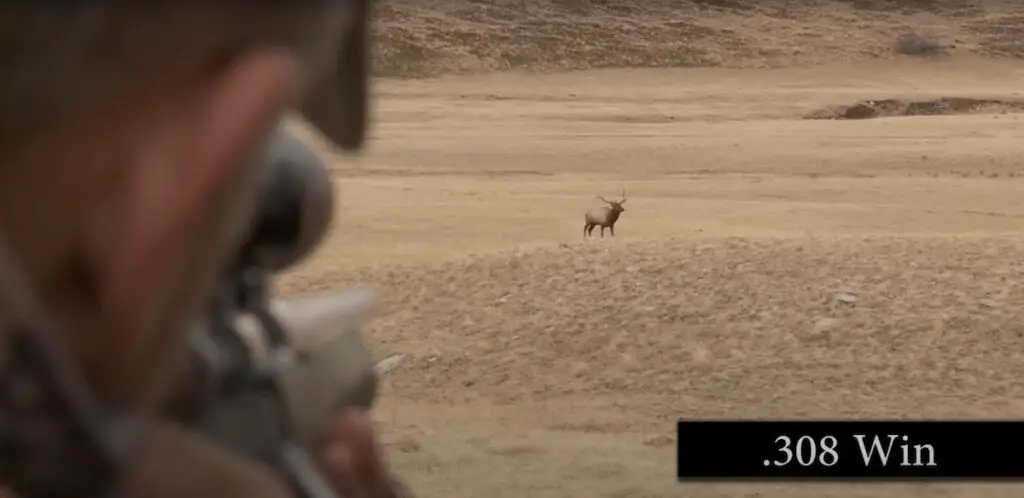
Are you specifically hunting brown or grizzly bear? What if you hunt in Alaska or Canada and need a heavy hitting cartridge just in case you find yourself on the wrong end of a grizzly/brown bear attack? Once again, both will work and choosing the better one here really depends on the situation.
The .45-70 Government is one of the best bear defense cartridges available and is certainly what I’d recommend for a hunt where shorter ranged shots are very likely. After all, there’s a reason why the Marlin Guide Gun is so popular among hunters and outfitters up in Alaska.
There are few other rifles I’d rather have in my hands if I had to deal with a charging brown bear!
The 308 Winchester will work on a bear hunt (even for brown bear), though it’s not near the top of the list of recommended cartridges for hunting the bigger bruins. If you foresee a situation where you’ll need to shoot at a bear outside the ideal range of a 45-70, then I’d recommend bumping up to something like a 300 Win Mag, 338 Win Mag, or even a 375 H&H instead.
Do you need a really heavy hitting cartridge ideally suited for hunting thick-skinned dangerous game like cape buffalo or water buffalo? While the 45-70 Government is technically a big bore round in the broadest sense of the word (and I’d definitely use it over the 308 if I had to pick just one of these two cartridges), I strongly recommend against using the 45-70 for hunting thick-skinned dangerous game.
Not everybody agrees with me on this subject. And to be fair, several hunters who have successfully and cleanly taken cape buffalo with the .45-70, especially with “magnum” 45-70 loads from companies like Buffalo Bore and Garrett.
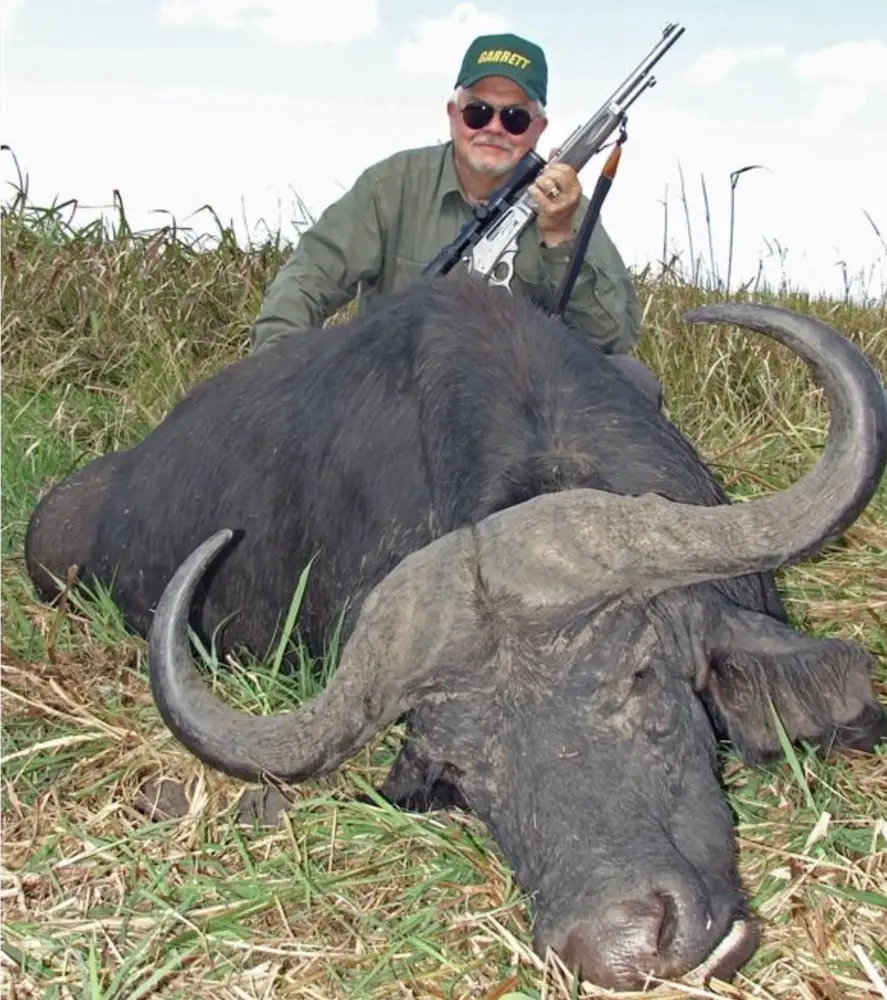
I think the .45-70 Govt is great cartridge, but there are good reasons NOT to hunt cape buffalo with it and I’ve written a comprehensive article explaining why I think hunting cape buffalo with the 45-70 is a bad idea.
Do you want to use a semi-automatic rifle for hunting (like for higher volume hog control work) or want a battle rifle for personal defense? The choice here is very easy: go with the .308 Winchester as it fills this niche just about perfectly, especially when chambered in a rifle like Ruger’s SFAR.
Are you looking for a great cartridge for sheep, mountain goat, or tahr hunting where you need an effective cartridge with manageable recoil in a lightweight and easy to carry rifle?
Of the two, the 308 Winchester is once again the superior choice for a hunt like this because of its flat trajectory, good resistance to wind drift, better energy retention at extended range, and it’s relatively light recoil.
The old 308 gets overshadowed by cartridges like the 6.5 Creedmoor, 6.5 PRC, and 270 Winchester for mountain hunting, but it will darn sure work in the right hands.
This guy in New Zealand in the video below does a great job of demonstrating just how effective the 308 can be on a hunt in rough country and at extended range with a couple shots on feral pigs!
45-70 vs 308 Final Thoughts
The 45-70 Government and 308 Winchester are both wonderful rifle cartridges for a diverse array of hunting situations.
I’d steer you towards the 308 Winchester if you’re looking for a better all-around cartridge that works great both up close and at longer range on medium and even big game.
The same is true for those who want a lighter recoiling round, who want the best selection of ammunition, or who prefer to hunt with bolt-action or semi-automatic rifles.
Likewise, I recommend the 45-70 Government for hunters unlikely to shoot at game past 100 (maybe 150) yards, as well as those who prefer lever action rifles and those who want a handier and easier to carry rifle.
The 45-70 is also the superior choice for those who want or need lots of power out of a big bore rifle for a close range situation where speed is of the essence.
To be perfectly candid with you, I own rifles in both cartridges and have had a lot of success afield with each one.
In fact, those rifles are among my favorites and I’d have a tough time discarding one in favor of the other.
In the end, though the differences between them (45-70 vs 308) are gigantic in many respects, they both excel in many different hunting situations of hunting tasks. Carefully analyze your needs, get a nice hunting rifle chambered in the cartridge that you think fits your specific hunting situation the best, learn to shoot it well, use quality bullets, and you’ll be well prepared for most common hunting situations.
There’s also no reason why you can’t own and hunt with both either like I do!
NEXT: 11 BEST HUNTING EAR PROTECTION OPTIONS FOR SPORTSMEN
NEXT: BEST GIFTS FOR HUNTERS
Enjoy this article comparing the 308 Winchester and 45-70 Government cartridges? Please share it with your friends on Facebook and Twitter.
The Lyman 50th Edition (p241-245 & p352-360), Hornady 10th Edition (p474-488 & p754-761), and Cartridges of the World (p125 & p158) were used as references for the history of the 308 Winchester and 45-70 Government cartridges. The data used to compare the trajectory and recoil of the cartridges was obtained from Hornady (here and here), Barnes (here and here), and Remington (here and here). Maximum pressure and data to compare cartridge sizes for the 45-70 vs 308 Winchester were obtained from SAAMI (here on p31 & p34). Case capacity information for the 45-70 vs 308 were obtained from Backfire.TV. Frontal surface area information was obtained from Chuck Hawks. I used Shooters Calculator to compare trajectories, wind drift, and recoil for the cartridges.
Make sure you subscribe to The Big Game Hunting Podcast and follow The Big Game Hunting Blog on Facebook, Instagram, Twitter, and YouTube.
John McAdams is a proficient blogger, experienced shooter, and long time hunter who has pursued big game in 8 different countries on 3 separate continents. John graduated from the United States Military Academy at West Point and is a veteran of combat tours with the US Army in Iraq & Afghanistan. In addition to founding and writing for The Big Game Hunting Blog, John has written for outdoor publications like Bear Hunting Magazine, The Texas State Rifle Association newsletter, Texas Wildlife Magazine, & Wide Open Spaces. Learn more about John here, read some of John’s most popular articles, and be sure to subscribe to his show: the Big Game Hunting Podcast.

